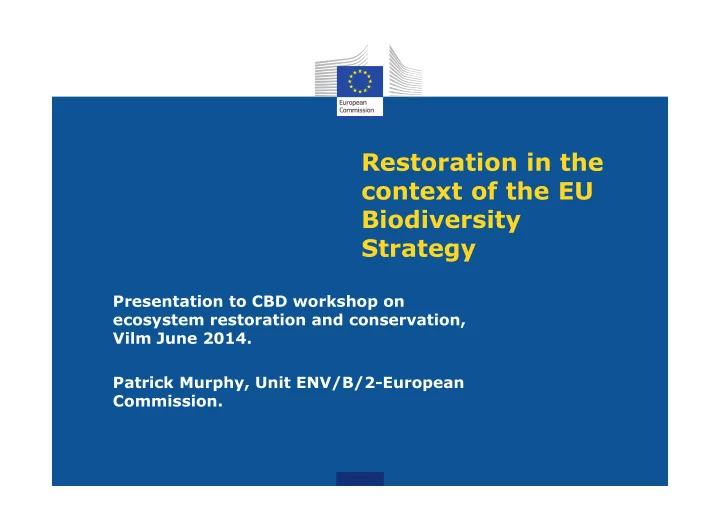

Restoration in the context of the EU Biodiversity Strategy Presentation to CBD workshop on ecosystem restoration and conservation, Vilm June 2014. Patrick Murphy, Unit ENV/B/2-European Commission.
The EU Biodiversity strategy Commission Communication of May 2011-Our Life • Insurance, our natural capital: an EU biodiversity strategy to 2020. Headline target to 2020- Halting the loss of • biodiversity and the degradation of ecosystem services in the EU by 2020 and restoring them in so far as feasible----. 6 operational targets and 20 associated actions. • Council conclusions and EP Resolution. • http://eur-lex.europa.eu/legal- • content/EN/TXT/?uri=CELEX:52011DC0244
Target 2 of the EU biodiversity Strategy By 2020, ecosystems and their services are maintained and enhanced by establishing green infrastructure and restoring at least 15% of degraded ecosystems
Actions related to Target 2 #5 Improve knowledge of ecosystems • and their services-MAES-2014 #6a- Framework for setting p-riorities for • Restoration- 2014 #6b- Green Infrastructure Strategy-by • 2012 #7a- Biodiversity Proofing -2014 • # 7b-No Net Loss of biodiversity and • ecosystem services-initiative by 2015.
Action 6a of the EU Biodiversity Strategy By 2014, Member States, with the assistance of the Commission, will develop a strategic framework to set priorities for ecosystem restoration at sub-national, national and EU level.
Process Working group of Member States' • experts and stakeholders (October 2012 to October 2013) Workshop –May 2013 • Support contract led by ARCADIS • Outputs on DG ENV webpage. • Status •
Terminology and Objectives - 1 Meanings of degraded and • restored. What is the extent of degraded • ecosystems in the EU? Are restoration objectives the • same for all ecosystems?
Terminology and Objectives-2 Can anywhere in the EU be described as • being in a "natural state"? Natural/semi-natural areas cover only 1- • 2% of the land surface. What ecosystem types do we have in the • EU- (Urban, Cropland, Grassland, Woodland and Forest, Heathland and Shrub, Sparsely Vegetated Land, Freshwater, Marine- MAES Classification.)
Terminology and Objectives- 3 If virtually all of EU territory is "degraded" • then are we intending to restore 15% of the entire territory of the EU by 2020? What are our restoration objectives.? • Are restoration objectives always the • same? –what about the influence of land- use, history, location etc?
Restoration is a process and not necessarily a final destination. For any ecosystem type, several states or • ecological conditions can be described along a continuum from poor to excellent. Any significant improvement that moves an area to a better state/condition should be regarded as a contribution to the 15% restoration target.
• Process of restoration needs to be defined in a better way (see conceptual model Hobbs ‘Restoration’ & Harris for understanding ecosystem states and transitions) � work with restoration levels! 11
12
What information do we have to support this approach? What are useful descriptors of • ecosystem condition? Appropriate descriptors will be • dependent on the ecosystem type. What information do we have? • What are we doing to improve the • information/knowledge base? The MAES initiative •
The Nature of the 15% Target Q-15% of what-is everything to be • included in the calculation? A-All EU territory is included within • the scope of the 15% restoration target. Based on the principle that no location should be regarded as non-restorable- ecological conditions and functions can always be improved.
The Nature of the 15 % Target-2 Q-Land vs Sea? • A-15% for the Land and 15% for the • Sea. Q-Across the EU or Member State by • Member State? A-15% restoration within the • territory of each MS. No burden sharing.
Links to other policies and actions. Nature conservation- • birds/habitats directives (Natura 2000) Freshwater and Marine (Water • Framework Directive and Marine Strategy Framework Directive) Air Pollution. • Eutrophication and Soil Protection. •
The Baseline To measure an improvement you • need a reference point. Previous experience. • The 2010 EU biodiversity baseline • (EEA Report) has been identified as the reference point.
Challenges 1 EU 2020. Growth and jobs. • Restoration as a generator of • growth and jobs. Restoration as a contribution to • climate change adaptation and protection against natural disasters.
Challenges 2 Financing restoration • EU funding mechanisms • National plans and for restoration • Restoration as part of the • Operational Programmes under Cohesion Policy. Restoration as part of the Rural • Development Programmes under CAP.
Challenges 3 Links to other policies. • Reducing pressures-contribution to • 15% Increasing awareness • Knowledge and funding constraints • The capacity of the restoration • sector
The next steps Guidance to Member States • Restoration to be included in PAs • RDPs and OPs. In 2014 Member States develop • their prioritization frameworks at national and sub-national level.
http://ec.europa.eu/environment/nature/biodiversity/co mm2006/pdf/2020/RPF.pdf http://ec.europa.eu/environment/nature/biodiversity/co mm2006/pdf/2020/Fin%20Target%202.pdf http://ec.europa.eu/environment/nature/knowledge/eco system_assessment/index_en.htm http://ec.europa.eu/environment/nature/ecosystems/in dex_en.htm
Thank you for your attention. The End Patrick Murphy patrick murphy@ec.europa.eu
Recommend
More recommend